 Occasionally I’ll crowdsource, as it were, a childhood memory. I was born and grew up in Oshawa, Ontario, living there between 1957 and 1976. Other than brief work-related stays from December 1983 to September 1984, and again from June to September 1992, I haven’t lived there since 1976, some 46 years ago. So when I needed help recalling a particular used and rare books dealer, my go-to place for research was the private Facebook group Vintage Oshawa, which has about 19,400 members and describes itself as “a place to post pictures, memorabilia & share tales of Oshawa past (pre-1980).” After all, 19,400 heads might be better than one in this case, I reasoned. And I had success almost four years ago back in May 2018 when I asked in classic Facebook style “who remembers” Rose Bowl Fish and Chips that operated at the corner of Bond and Prince streets? More than 200 members of the group either liked the question or responded with a comment.
Occasionally I’ll crowdsource, as it were, a childhood memory. I was born and grew up in Oshawa, Ontario, living there between 1957 and 1976. Other than brief work-related stays from December 1983 to September 1984, and again from June to September 1992, I haven’t lived there since 1976, some 46 years ago. So when I needed help recalling a particular used and rare books dealer, my go-to place for research was the private Facebook group Vintage Oshawa, which has about 19,400 members and describes itself as “a place to post pictures, memorabilia & share tales of Oshawa past (pre-1980).” After all, 19,400 heads might be better than one in this case, I reasoned. And I had success almost four years ago back in May 2018 when I asked in classic Facebook style “who remembers” Rose Bowl Fish and Chips that operated at the corner of Bond and Prince streets? More than 200 members of the group either liked the question or responded with a comment.
How we consolidate, access and sometimes geographically transpose locations in long-term memory is a complex process beyond the ken of my knowledge of neuroscience, but here is what I asked earlier today based on what I suspected to be a real but perhaps flawed memory:
“Does anyone recall a used bookstore on Division Street in Oshawa in the 1970s and 1980s, not far from the old General Motors North Plant? Brown brick, I think, like other buildings in the neighbourhood. A bit dingy in terms of lighting inside but not without its charms. I think the name might have started with the letter M, but it was all quite a while ago. Given that we’re talking about 40 or 50 years ago, it’s also possible I’ve conflated the idea of a bookstore on Division Street in the area of the GM North Plant with a health food/Asian vegetable market store in that location and the bookstore was on the west side of Simcoe Street South, near John Street East, not far south of a Pepi’s Pizza location on that corner. I still have fond, though distant memories of my friend Mike Byrne, working there as a cook in high school circa 1973-74, and wrangling his friends the odd late-night pie … the pepperoni pizza … greasy, yes, sure. But superb also.
The mention of Pepi’s Pizza was perhaps not essential to answering the question, given the focus is on a bookstore and Asian grocery store, but mentioning a favourite childhood eatery in Oshawa, be it Pepi’s or Mother’s Pizza Parlour and Spaghetti House, or perhaps Red Barn or Burger Chef, always is a good memory prompt for any even tangentially related story I’ve found as a writer.
So what did I learn today from folks in Vintage Oshawa? When I said, I think the name might have started with the letter M,” turns out I was correct as dozens of readers spelled it out for me as Morgan Self, which I instantly knew as correct. But commenters went well beyond that in their help. Apparently, there were two Morgan Selfs who were proprietors of their … err … self-named bookstore, father and son. And they lived on Shakespeare Avenue another commenter noted (their bookstore was at 84 Simcoe St. S.) Now, I confess my fact-checking skills as a blogger aren’t perhaps as well-honed as they had to be as a pre-Google and pre-Wikipedia copy editor on the rim at daily newspapers, but I just had to Google Shakespeare Avenue to make sure this was by the book and there was such a street in Oshawa (I didn’t recall it) and I wasn’t being audaciously pranked on social media prior to April 1. Turns out to be legit. There is such a street. Whether the book-selling Selfs lived on it would take more verification for a newspaper back in the day, but for us present-day bloggers, not so much. Editors in their day were the last-line-of-defence fact checkers. When you wear a writer’s hat, you are a storyteller and there’s an admonition that a writer should never let the facts stand in the way of a good story. This was true even before 2017 when Sean Spicer came along and elevated the notion to high principle. That said, the photograph accompanying this post is admittedly for illustration purposes only. It is not the inside of the long-gone Morgan Self bookstore in Oshawa. At least I think it’s not.
You can also follow me on Twitter at: https://twitter.com/jwbarker22
Tag Archives: Pepi’s Pizza
Aloha: ‘Yes’ or ‘No’ to Hawaiian pizza?
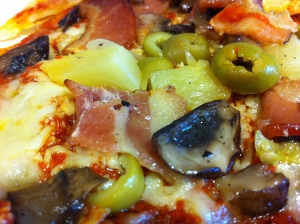 In the Great Pizza debate there is really only one main question: Is Hawaiian pizza a delight or an abomination?
In the Great Pizza debate there is really only one main question: Is Hawaiian pizza a delight or an abomination?
Sure, there are some subsidiary questions connoisseurs ask about, such as whether anthracite coal-fired or wood-fired ovens bakes a better pizza pie, although it’s a bit of an apples and oranges comparison because the answer partly depends on the kind of cheese topping and other ingredients, or whether the best pizzas in North America come out of a handful of pizza joints in New York City or New Haven, Connecticut? That sort of thing.
Coal-fired ovens typically run between 800°F and 1,000°F, sometimes even higher, according to Pizza Today, the industry’s leading trade magazine, which was launched in 1984 by pizzeria owner Gerry Durnell in the tiny town of Santa Claus, Indiana.
Durnell had worked his way through college as a rock and roll disc jokey, a TV cameraman, and as an announcer for the Ozark Jubilee. He was running an ice cream shop in Santa Claus, in southwestern Indiana, not too far from the Kentucky state line , when he decided to add baking pizzas to his restaurant menu.
In a Dec. 15, 2104 article in Pizza Today, headlined “Respecting the Craft: Wood vs. Coal,” Tony Gemignani, who got his start in 1991 as a pizza thrower at his brother’s Pyzano’s Pizzeria in Castro Valley, California, notes “specialty cheese like a dry mozzarella, also known as a Caprese loaf, is common. This cheese is typically sliced and applied before the sauce. Common pizzas are tomato pies, clam and garlic, and sausage, says Gemignani, the first and only Triple Crown winner to date for baking at the International Pizza Championships in Lecce, Italy. “When you’re cooking at such a high temperature, even higher than a wood-fired oven,” he says, “you still have a longer bake time because a coal oven doesn’t have a high flame like a wood-fired oven. The pizza is typically 16 to 18 inches in diameter and is charred yet pliable. It has a slight crispness, with some stability.
“A wood-fired oven typically runs between 650°F and 900°F. At 900°F, pizzas can cook in 60 to 90 seconds. Fresh mozzarella and buffalo mozz are typically used. The pizzas that come from these ovens are typically 11 to 13 inches in diameter and come out of the ovens charred, soft, delicate and sometimes wet (even soupy at times). They are not recommended for delivery.
“When it comes to the price of wood and coal, they are very similar.”
Lombardi’s (a favourite of Italian tenor Enrico Caruso) was founded in 1905 on Spring Street in the Little Italy section of Manhattan in New York City, and is the oldest pizzeria in the United States. While it is generally agreed pizza originated in Italy, the date of its invention is hard to pin down with exactitude.
Neapolitan pizza is first mentioned by name in the late 18th century, and that’s usually considered to be the origin date for pizza, but a minority opinion in recent years is that pizza dates back to 997 in the 10th century, when it appears on a Latin list of foods to be supplied annually at Christmas and Easter as a tithe to the archbishops of Gaeta (“whether to us or our successors”) in central Italy, payable by the tenants of a mill on the nearby Garigliano River.
In support of the later Naples origins of pizza theory, an often recounted story holds that on June 11, 1889, to honour the Queen consort of Italy, Margherita of Savoy, the Neapolitan pizza-maker Raffaele Esposito created the “Pizza Margherita”, a pizza garnished with tomatoes, mozzarella, and basil, to represent the national colours of Italy as on the Italian flag.
Carol Helstosky, an associate professor of history at the University of Denver, and the author of Pizza: A Global History, told CBC Radio earlier this year that “pizza never had that great a reputation throughout much of its history. As people tried pizza, it had its origins in Naples, right, in the 17th century. And as people outside of Naples, even other Italians or foreigners, tried pizza they reacted with absolute disgust. I believe American inventor Samuel Morse, when he visited Naples and tried pizza, he described that as a type of ‘nauseous cake.'”
In Naples, Helstosky says, there were several different types of pizza, but “mostly pizza was consumed by the poorest of the Neapolitans – soldiers, workers, families who didn’t have access to kitchens and purchased cheap street food. This was also a place where people could eat pasta street side, and so pizza would be a cheap takeaway snack. And so the pizzaiolo would make pizza out of whatever ingredients he happened to have on hand. Near Naples, tomatoes were certainly popular but also fish. And then some mozzarella made out of buffalo milk, fresh herbs like basil or oregano. Whatever was on hand would be sprinkled on top of a pizza.”
Morse, who hardly tried to telegraph his opinion on the matter, apparently was of a minority view on the subject of pizza, which in the 21st century is, if not quite a universal dish worldwide, well, at least and international dish. In March 2015, Pope Francis told Valentina Alazraki, the veteran Vatican correspondent for Mexico’s Noticieros Televisa, the only thing he really missed after two years as pope was the ability “to go out to a pizzeria and eat a pizza,” adding that even as Cardinal Jorge Mario Bergoglio in Buenos Aires he was free to roam the streets, particularly to visit parishes (https://soundingsjohnbarker.wordpress.com/2015/03/15/catholic-cooking-from-pope-francis-love-for-buenos-aires-pizzerias-to-father-leo-patalinghug-the-tv-show-filipino-cooking-priest/).
Almost half the population of Buenos Aires can rightfully claim Italian heritage, so it is little surprise the Argentinian capital is so well-known for its Napoletana pizza. “The only thing I would like is to go out one day, without being recognized, and go to a pizzeria for a pizza,” Pope Francis said, comparing his life now to how it was when he was Archbishop of Buenos Aires. “In Buenos Aires I was a rover. I moved between parishes and certainly this habit has changed. It has been hard work to change. But you get used to it,” Pope Francis told Alazraki.
Last year I wrote about Glenview, Illinois-based Family Video (https://soundingsjohnbarker.wordpress.com/2016/01/17/who-shot-the-video-store-and-how-did-glenview-illinois-based-family-video-survive-to-thrive-and-still-rent-movies-and-now-sell-pizza/), which continues to survive and thrive and still rent movies, but also mentioned how they now sell pizza made in their video stores from Marco’s Pizza of Toledo, Ohio. Marco’s Pizza, founded in 1978 by Pasquale “Pat” Giammarco, is one of the fastest-growing pizza franchise operations in the United States. The Toledo-based delivery pizza franchisor opened 116 stores in 2015. Pizza is a $46- billion market in the United States that continues to grow at a rate of about one to two per cent per year.
I’ve written here and elsewhere about driving a Plymouth Duster to deliver for Mother’s Pizza Simcoe North in Oshawa during my last spring in high school for $2.65 per hour – plus tips (https://soundingsjohnbarker.wordpress.com/2014/09/15/a-taste-for-yesterday-mothers-pizza-and-pepis-pizza/). Mother’s was an iconic Canadian pizza parlour chain from the 1970s – with its swinging parlour-style doors, Tiffany lamps, antique-style chairs, red-and-white checked gingham tablecloths, black-and-white short silent movies shown on a screen for patrons waiting for their meal to enjoy, root beer floats and pizzas served on silver-coloured metal pedestal stands.
I also recall writing on Oshawa’s “Share Your Memories” webpage that “in keeping with the spirit of the thing, my own comment Feb. 3 [2014] reads, ‘Pepi’s Pizza, eh? Simcoe and John streets. I had a friend who worked there circa 1973-74. I still have fond memories of the pepperoni pizza … greasy, yes, sure. But superb also.’”
Mother’s Pizza was founded in 1970 by three partners, Grey Sisson, Ken Fowler and Pasquale Marra, and got its start in the Westdale Village area of Steeltown. The chain eventually grew to about 120 locations in Canada, the United States and England.
In 2008, Brian Alger acquired the then-expired trademark to Mother’s Pizza – one of his favourite childhood brands – and along with another entrepreneur, Geeve Sandhu, re-opened April 1, 2013 at 701 Queenston Rd. in Hamilton, Ont.
When Sam Panopoulos emigrated, along with his two brothers, when he was 20, from Greece to Canada in 1954, pizza was an oddity. “Pizza wasn’t in Canada – nowhere,” he told CBC Radio’s As It Happens last February.
“At the time, the food was available in Detroit and was slowly making its way to neighbouring Windsor, Ont., not far from Chatham, Ont., the small town where Panopoulos had settled and opened a restaurant,” CBC reported.
“When visiting Windsor, he dined on pizza and decided to try making it at home. ‘Those days, the main thing was mushrooms, bacon and pepperoni. There was nothing else going on the pizza,'” said Panopoulos.
“Inspired by a can of pineapple on his shelf, he took a chance and tossed the fruit on his pizza. The year was 1962. Hawaiian pizza had arrived at the Satellite Restaurant in Chatham.
“We just put it on, just for the fun of it, see how it was going to taste,” Panopoulos told the BBC News last February. “We were young in the business and we were doing a lot of experiments.
“Customers ended up loving the savoury sweetness of the dish.
“The creation also capitalized on the mid-century tiki trend, which popularized Polynesian culture in North America.
“Nobody liked it at first,” said Panopoulos. “Those days nobody was mixing sweets and sours and all that. It was plain, plain food.”
That debate continues 55 years later. Icelandic President Guðni Th. Jóhannesson made world headlines earlier this year at a university in Iceland, in a story that became known as “Pineapplegate” after he was asked whimsical question about his views on pineapple as a topping on pizza and he responded in a lighthearted way that he thought that it should be banned and that he was “fundamentally opposed” to pineapple on pizza and suggested. “I like pineapple, just not on pizza. But I can’t make laws that make it illegal for people to put pineapples on their pizzas,” Guðni said. “I am happy I don’t have that authority, presidents shouldn’t be tyrants. I wouldn’t want to live in a world where those in my position could ban things they don’t like. But I recommend putting seafood on pizza.”
Sam Panopoulos, who was 83, died last month. “From what I have read, Sam was a decent man with a good sense of humour,” Guðni wrote on Facebook. “Indirectly you could say we crossed paths after I jokingly (yeah, right) said that this particular topping should be banned.”
Me? Well, I don’t know that I tried any kind of pizza until maybe the early 1970s when I was 13 or 14. My parents came a bit late to the appeal of pizza, although I do recall my dad heading out on the occasional Friday night when some of my Nipigon Street friends, perhaps Mike Byrne and Paul Sobanski, were over, and dad coming back with a box of Mothers Pizza from Simcoe North, the first and only Mothers in Oshawa at the time.
I think I may have had my first Hawaiian pizza in the late spring or early summer of 1976, at the very, very end of my Oshawa Catholic High School Grade 13 days, on a picnic table at Lakeview Park in the south end of Oshawa on the north shore of Lake Ontario, hanging out in those last glorious days of high school freedom with my comrades in numerous adventures, both big and small, Ann Marie (a.k.a. Annie and A.M.) McDermott, and Gerry Byrne, both of whom are friends to this day. I might even have been just finishing up my part-time after-school driving job for Mothers Pizza Simcoe North at the time, as I got ready to move to a higher-paying student summer job at General Motors of Canada, before beginning my higher learning at Trent University in Peterborough, Ontario that September.
The Hawaiian pizza verdict? Well, last night I had both chunks of pineapple and anchovies’ paste on the pizza I constructed at home (pictured above), suggesting I’m quite OK with mixing sweets and sours, and enjoy the savoury sweetness of the Hawaiian pizza model (I tend to improvise a bit) that Sam Panopoulos first offered us in 1962 at his Satellite Restaurant in Chatham.
Thanks, and aloha, Sam!
You can also follow me on Twitter at: https://twitter.com/jwbarker22
The Accidental Lowbrow Fast Food Blogger
Back in September 2014, I’d never have guessed some 80,000 views and 2½ years later, how often I’d have written about food, especially fast food joints and other greasy spoons in Canada and the United States. I’m not quite sure what I thought I was going to be writing about, but I don’t remember food being on my composing radar for blog posts. Premillennial dispensationalism? The Rapture? Young Earth Creationism? Spiritual Warfare? Petrus Romanus? Prophecy of St. Malachy or Prophecy of the Popes? Any and all things Catholic? Sure, all of these and more, some pretty arcane and from the fringe of the respectable-thinking universe. But food? Who’d a thunk it?
Admittedly, I had written on occasion about food, especially fast food, prior to venturing forth with soundingsjohnbarker (https://soundingsjohnbarker.wordpress.com/) but not that often. Mainly if it involved a road trip from Southern Ontario to New England or vice-versa that wound up taking me to my favourite Red Barn, up in the Adirondacks in Troy, New York, or something got me thinking about high school back in Oshawa, Ontario and memories of Mother’s Pizza and Pepi’s Pizza. That sort of thing.
Just taking a quick look here, it looks like I’ve become an insatiable lowbrow fast food blogger who dreams of being to blogging what Guy Fieri of Diners, Drive-Ins and Dives is to TV. And that’s just looking for headlines that trumpet food, not so much others posts that mention food either in a secondary or passing fashion, overshadowed by a main non-food story. Last year I wrote about Glenview, Illinois-based Family Video (https://soundingsjohnbarker.wordpress.com/2016/01/17/who-shot-the-video-store-and-how-did-glenview-illinois-based-family-video-survive-to-thrive-and-still-rent-movies-and-now-sell-pizza/), which continues to survive and thrive and still rent movies, but also mentioned how they now sell pizza made in their video stores from Marco’s Pizza of Toledo, Ohio. Marco’s Pizza, founded in 1978 by Pasquale “Pat” Giammarco, is one of the fastest-growing pizza franchise operations in the United States. The Toledo-based delivery pizza franchisor opened 116 stores in 2015. Pizza is a $46- billion market in the United States that continues to grow at a rate of about one to two per cent per year.
In a similar vein, I’ve written a couple of times about the Burntwood Curling Club’s monthly, from November to April anyway, fundraising pickerel fish fry, now in its third season, to bring in some revenue at $20 a plate for the older crowd and $10 a plate for those 12 and under, with proceeds going towards what it cost to replace the club’s aging ice plant, a big ticket six-figure item for curling clubs. The last fish fry of the season is set for Monday, April 3 in the upstairs club lounge from 5 p.m. to 7:30 p.m. The fish fry involves club volunteers cooking about 50 pounds per fish fry of fresh pickerel, also known as walleye, from the commercial fish packing station in Wabowden. Pickerel is the most valuable commercial fish catch in Manitoba, with an average value of about $20 million per year, which is about 70 per cent of the landed value of all species, and comprise more than 40 per cent of commercial fish production in the province by weight. Am I writing primarily about curling or pickerel? I suppose some of both really, but I know a bit more about pickerel. Jeanette and I are looking forward this spring and summer to marking a decade fishing together off the dock for pickerel at Paint Lake Marina!
I’ve written here and elsewhere about driving a Plymouth Duster to deliver for Mother’s Pizza Simcoe North in Oshawa during my last spring in high school for $2.65 per hour – plus tips (https://soundingsjohnbarker.wordpress.com/2014/09/15/a-taste-for-yesterday-mothers-pizza-and-pepis-pizza/). Mother’s was an iconic Canadian pizza parlour chain from the 1970s – with its swinging parlour-style doors, Tiffany lamps, antique-style chairs, red-and-white checked gingham tablecloths, black-and-white short silent movies shown on a screen for patrons waiting for their meal to enjoy, root beer floats and pizzas served on silver-coloured metal pedestal stands.
Maybe we all just love food, no?
In Winnipeg, we have V.J.’s Drive Inn at at Broadway and Main with its overstuffed double chili cheese dogs, greasy spoon certified cheeseburgers, golden fries and chocolate milkshakes, all for the more discerning among the Fort Garry Hotel clientele methinks.
And speaking of chili dogs: should you ever find yourself down in Durham, North Carolina, you can’t go wrong enjoying a meal at The Dog House, locally owned and in business in Durham since 1970, and serving up an assortment of Bull-Dogs, Boxer Dogs, Collie Dogs, Hound Dogs, Puppy Dogs, Ol’ Yallows and the like.
Living in North Carolina was where I developed tastes for chili dogs, deep-fried cornmeal-batter Hushpuppies, pork barbecue and fat back, cracklins and wash pot pork rinds, while prudently not losing said tastes by overdoing it with low-density lipoproteins (LDL) cholesterol testing at nearby Duke University Medical Center, although I visited the world-class medical facility for other ailments on occasion.
The Dog House says its chili is made from a family recipe with pure beef, and no beans, soy or other fillers; just a blend of secret spices and 47 years of experience.
As for the slaw, it is “not too sweet and not too spicy,” and always freshly made.
But closer to home, when you’re appetite is a bit larger than a sausage dog or one of its cousins, my pick is Lovey’s BBQ in St. Boniface for hand trimmed briskets, pork shoulders and ribs. Yum!
Sometimes you get to combine your writing interests, say about Catholicism and food, as I did in “Catholic cooking: From Pope Francis’ love for Buenos Aires pizzerias to Father Leo Patalinghug, the TV show Filipino ‘Cooking Priest’” (https://soundingsjohnbarker.wordpress.com/2015/03/15/catholic-cooking-from-pope-francis-love-for-buenos-aires-pizzerias-to-father-leo-patalinghug-the-tv-show-filipino-cooking-priest/)
I combined Catholicism and food on a few other occasions as well: In “‘Make mine halibut, please’: Fish-and-chips-Catholic-on-Friday” (https://soundingsjohnbarker.wordpress.com/2014/11/07/make-mine-halibut-please-fish-and-chips-catholic-on-friday/) I wrote that until Blessed Pope Paul VI proclaimed Paenitemini (Apostolic Constitution On Penance) on Feb. 17, 1966, which allowed episcopal conferences to permit Catholics in their jurisdictions to substitute some other penitential practice aside from abstaining from meat on Fridays. Catholics had been eating fish on Friday under an edict in force in the universal church since Pope Saint Nicholas 1, also known as Saint Nicholas the Great, in 851. With the exception in Canada of Ash Wednesday and Good Friday in accordance with the prescriptions of Canon 1253, proclaimed in 1983. Fridays are days of abstinence, but Canadian Catholics can substitute special acts of charity or piety on this day.
No need to feel too sorry though for us fish eaters for having to forgo meat on Fridays from 851 to 1966. We made up for it on an annual basis on “Fat Tuesday,” which fell on Feb. 28 this year. Fat Tuesday. Mardi Gras. Máirt Inide. Dydd Mawrth Ynyd. Fastnacht. Fastelavn. Sprengidagur. Güdisdienstag. Vastlapäev. Užgavėnės. Fettisdagen. Laskiainen. Shrove Tuesday. Call it what you will, but we made sure we ate – and ate big and ate rich – on this moveable feast, based on the lunar cycles of the moon – the last day of Shrovetide before the penitential season of Lent begins on Ash Wednesday, which is its colloquial name. Dating to the A.D. 900s, the official name is the Day of Ashes. Come to think of it, even though we can eat meat on Fridays now outside of Lent, we remain fond of Shrove Tuesday.
“If smell and sound are important to Catholics, so, too, taste,” I wrote in a blog post headlined “With our O antiphons, Smoking Bishops and ‘sinful servants’ we are the Church Militant on Earth.” I noted that we had borrowed the “Smoking Bishop,” a mulled wine wassail, “in a spirit of ecumenical breaking of bread at table” from our “Anglican or Episcopalian brothers and sisters, particularly Charles Dickens, a heterodox Anglican if ever there was one, who wrote A Christmas Carol after he journeyed to Lancashire in the summer of 1843 to see for himself how life was lived in the industrial north of England. He completed the book that fall in six weeks and the book was published on Dec. 19, 1843 (https://soundingsjohnbarker.wordpress.com/2014/12/18/with-our-o-antiphons-smoking-bishops-and-sinful-servants-we-are-the-church-militant-on-earth/).
“A merry Christmas, Bob!” said Scrooge, with an earnestness that could not be mistaken, as he clapped him on the back. “A merrier Christmas, Bob, my good fellow, than I have given you, for many a year! I’ll raise your salary, and endeavour to assist your struggling family, and we will discuss your affairs this very afternoon, over a Christmas bowl of Smoking Bishop, Bob!”
It is in that spirit we offer you this recipe for a Smoking Bishop, courtesy of Cedric Dickens, a great-grandson of Charles Dickens, published in his 1988 book, Drinking with Dickens:
Smoking Bishop
6 Clementines
1/2 C sugar
30 cloves
8 C moderately sweet red wine
1 bottle ruby port
Bake the oranges in a medium oven for about 20 minutes. Stick cloves into the oranges and then put them into a large bowl. Pour the wine over them and add the sugar. Cover and leave in a warm place for 24 hours. Squeeze the juice from the oranges and mix it with the wine. Add the port and heat the mixture in a pan. Do not boil. Serve hot.
And you can be pretty sure that while I might not post about it on soundingsjohnbarker, I’m quite likely to put in a bit of a plug on my Facebook page at least for annual Grilled Cheese Sandwich Day come Wednesday, April 12. I’ve done so for the last two years.
Melting cheese on top of bread is a culinary concept that has been around since the time of Ancient Rome, but modern grilled cheese sandwiches, as we know them, didn’t become popular until the 1920s. Due to the ready availability of cheese and sliced bread for the average consumer by the early 20th century, they became an American staple, but a connoisseur’s love for grilled cheese sandwiches also spread around the world.
Thanksgiving, of course, gives me a change to give holiday nod to turkey, such as in this piece, “Mouthwatering American Thanksgiving recipes correction in the New York Times and other pardonable acts” (https://soundingsjohnbarker.wordpress.com/2014/11/27/mouthwatering-american-thanksgiving-recipes-correction-in-the-new-york-times-and-other-pardonable-acts/):
“Correction: November 26, 2014
“An article last Wednesday recommending a Thanksgiving dish from each state, with a recipe, contained numerous errors.
“The recipe from Connecticut, for quince with cipollini onions and bacon, omitted directions for preparing the quince. It should be peeled, cored and cut into 1-inch chunks. An illustration with the West Virginia recipe, for pawpaw pudding, depicted a papaya — not a pawpaw, which is correctly depicted above. The introduction to the recipe from Arizona, for cranberry sauce and chiles, misstated the origin of Hatch chiles. They are grown in New Mexico, not in Arizona.
“The introduction to the Delaware recipe, for du Pont turkey with truffled zucchini stuffing, referred incorrectly to several historical points about the Winterthur estate. It was an ancestral home of the du Pont family, not the sole one; it was established in 1837, not in 1810; the house was completed in 1839, not in 1837. The introduction also misstated the relationship of Pauline Foster du Pont to Eleuthère Irénée du Pont. Pauline was the wife of Mr. du Pont’s grandson, not his daughter-in-law.
And I wouldn’t be much of a former New Englander, if after enjoying a “blue” rare steak, I didn’t enjoy scarfing down some super premium ice cream, like Steve’s Ice Cream, named after Steve Herrell, as it was in the early 1980s at the original location on Elm Street in Davis Square in Somerville, Massachusetts, or Ben & Jerry’s Homemade, Inc., which got its its start in a renovated gas station at the corner of St. Paul and College streets in Burlington, Vermont. In 1980, they were showing movies on summer Saturday nights on an outside wall of the gas station, I remember.\
Burgers have been the continuing jackpot for my food entries, however, which may not surprise many. What might surprise you, however, is the relatively big numbers (outpacing anything I’ve written on Thompson city council, can you believe it?) has been for two posts on two defunct American burger chains, both of which also operated for a time in parts of Canada, particularly in the 1970s.
Apparently former employees of the two burger chains and hungry aficionados who remember them fondly, salivate, or so it seems, to a helping of words on the Red Barn and Burger Chef, gone, but never forgotten.
Both stories get read pretty much daily somewhere in the world and “Red Barn, Big Barney and the Barnbuster” (https://soundingsjohnbarker.wordpress.com/2014/09/13/red-barn-big-barney-and-the-barnbuster/) was published here back on Sept. 13, 2014, while “Burger Chef: The story of the greatest might-have-been in the history of the fast food business” (https://soundingsjohnbarker.wordpress.com/2016/03/13/burger-chef-the-story-of-the-greatest-might-have-been-in-the-history-of-the-fast-food-business/) appeared originally on March 13, 2016.
You can also follow me on Twitter at: https://twitter.com/jwbarker22
A taste for yesterday: Mother’s Pizza and Pepi’s Pizza
Readers know that it’s not unheard of for me to sing the praises of some long-forgotten (by most anyway) defunct fast-food restaurant I have known, or present day greasy spoon. A reference to fried clams from the Northumberland Strait at Chez Camille’s in Cap Pelé, New Brunswick made it into the very first Latitude 55 column I wrote for the Thompson Citizen on July 25, 2007.
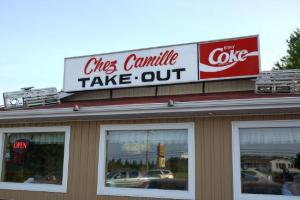
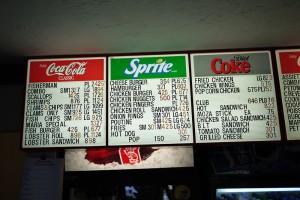
I got thinking about defunct fast-food restaurants I have known earlier this year when I stumbled on a webpage called “Share Your Memories – Oshawa’s Municipal Heritage Committee” at: http://www.heritageoshawa.ca/share_your_memories.php#post, which is dedicated to “Keeping Oshawa’s Heritage Alive.”. The page has apparently existed since Friday, Dec. 22, 2006, so I guess stumbled is the right word to describe me landing on it some seven and a bit years later.
What I noticed is how many of the contributors talked about bygone Oshawa restaurants and their fond food memories of yesteryear. On Dec. 22, 2010 – coincidentally four years to the day after “Share Your Memories” went up online – I wrote a Soundings column in the Thompson Citizen headlined, “Red Barn, Big Barney and the Barnbuster,” extolling the culinary wonders of the Red Barn, a fast-food restaurant chain founded in 1962 in Springfield, Ohio by Don Six, Jim Kirst and Martin Levine. Red Barn peaked in its heyday in the early 1970s with more than 400 restaurant locations in 22 states, as well as locations in Canada, and even a dozen in and around Melbourne, Australia.
On Feb. 20, 2013, I wrote a column ostensibly about my two university roommates, but also in part about driving a Plymouth Duster to deliver for Mother’s Pizza Simcoe North for $2.65 per hour – plus tips. Mother’s was an iconic Canadian pizza parlour chain from the 1970s – with its swinging parlour-style doors, Tiffany lamps, antique-style chairs, red-and-white checked gingham tablecloths, black-and-white short silent movies shown on a screen for patrons waiting for their meal to enjoy, root beer floats and pizzas served on silver-coloured metal pedestal stands.
I’m happy to say that in 2008, Brian Alger acquired the then-expired trademark to Mother’s Pizza – one of his favourite childhood brands – and along with another entrepreneur, Geeve Sandhu, re-opened April 1, 2013 at 701 Queenston Rd. in Hamilton, Ont. Mother’s Pizza was founded in 1970 by three partners, Grey Sisson, Ken Fowler and Pasquale Marra, and got its start in the Westdale Village area of Steeltown. The chain eventually grew to about 120 locations in Canada, the United States and England.
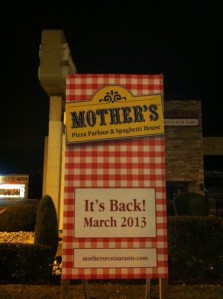
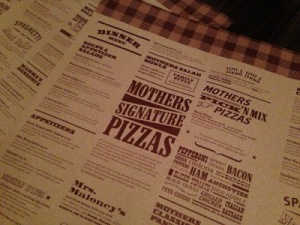
 “I have fond memories of downtown too with the lunch counters at Karn Drugs and Kresge’s. You could get a cheese sandwich and a glass of milk without it being enough food for two meals and costing $12,” Andrew McCarnan wrote on Oshawa’s “Share Your Memories” webpage on March 27, 2011.
“I have fond memories of downtown too with the lunch counters at Karn Drugs and Kresge’s. You could get a cheese sandwich and a glass of milk without it being enough food for two meals and costing $12,” Andrew McCarnan wrote on Oshawa’s “Share Your Memories” webpage on March 27, 2011.
That must have trigged thoughts of food among the site’s readers because a few days later on April 1, 2011, a poster known as doraryan@cogeco.ca wrote, “I was born and grew up in Oshawa. One of my memories as a child was going to the Oshawa Bakery after church on Sundays to get their warm rye bread. Does anyone know if their rye bread recipe is still in use and can you still get their bread?”
Clearly, food, especially not particularly fancy fast-food, resonates for us working stiffs from Canada’s Motor City. The closer I looked, the more I realized many, if not most commenters, had at some point mentioned a bygone restaurant or food favourite in their posting. Vince Robichaud on Sept. 29, 2012 wrote, “I don’t know if anybody remembers Mike’s French fry truck that drove around selling fries. The truck was a 1948 Dodge Fargo. The best fries in town, back in the 60s.”
In keeping with the spirit of the thing, my own comment Feb. 3 reads, “Pepi’s Pizza, eh? Simcoe and John streets. I had a friend who worked there circa 1973-74. I still have fond memories of the pepperoni pizza … greasy, yes, sure. But superb also.”
Pepi’s Pizza restaurant locations in Oshawa were owned by the Firmi family. Brothers Lewis and Ron Firmi opened the doors of Pepi’s Pizza, still famous for its handmade dough, at the corner of Water and Weber streets in Kitchener in 1962.
The Record, Kitchener’s daily newspaper, reported on Dec. 20, 2014 (https://www.therecord.com/shopping-story/5216482-history-of-pepi-s-pizza-kitchener/): “Most people expected the restaurant to fail soon after it opened. They thought the brothers were crazy, that pizza would never catch on. The brothers were determined to prove people wrong and to encourage customers to give it a try. They offered incredible specials, such as all you can eat pizza on Friday nights for a dollar.
Rhonda Firmi, the daughter of one of Pepi’s founders, and her husband John Guy, have been operating the remaining three Kitchener Pepi’s Pizza locations for more than a decade.
You can also follow me on Twitter at: https://twitter.com/jwbarker22



